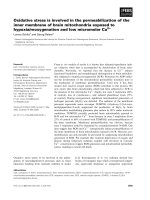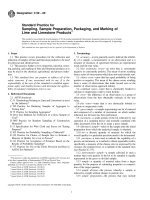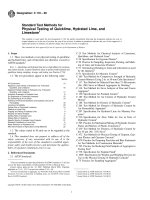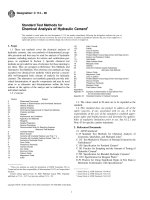Designation: C 452 – 95 - Potential Expansion of Portland-Cement Mortars Exposed to Sulfate1 pps
Bạn đang xem bản rút gọn của tài liệu. Xem và tải ngay bản đầy đủ của tài liệu tại đây (26.14 KB, 3 trang )
Designation: C 452 – 95
Standard Test Method for
Potential Expansion of Portland-Cement
Mortars Exposed to Sulfate
1
This standard is issued under the fixed designation C 452; the number immediately following the designation indicates the year of
original adoption or, in the case of revision, the year of last revision. A number in parentheses indicates the year of last reapproval. A
superscript epsilon (e) indicates an editorial change since the last revision or reapproval.
1. Scope
1.1 This test method, which is applicable only to portland
cements, covers the determination of the expansion of mortar
bars made from a mixture of portland cement and gypsum in
such proportions that the mixture has a sulfur trioxide (SO
3
)
content of 7.0 mass %.
1.2 The values stated in SI (Practice E 380) units are to be
regarded as the standard.
1.3 This standard does not purport to address all of the
safety concerns, if any, associated with its use. It is the
responsibility of the user of this standard to establish appro-
priate safety and health practices and determine the applica-
bility of regulatory limitations prior to use.
2. Referenced Documents
2.1 ASTM Standards:
C 109/C 109M Test Method for Compressive Strength of
Hydraulic Cement Mortars (Using 50-mm (2-in.) Cube
Specimens)
2
C 150 Specification for Portland Cement
2
C 230 Specification for Flow Table for Use in Tests of
Hydraulic Cement
2
C 305 Practice for Mechanical Mixing of Hydraulic Cement
Pastes and Mortars of Plastic Consistency
2
C 471 Test Methods for Chemical Analysis of Gypsum and
Gypsum Products
2
C 490 Practice for Use of Apparatus for the Determination
of Length Change of Hardened Cement Paste, Mortar, and
Concrete
2
C 511 Specification for Moist Cabinets, Moist Rooms, and
Water Storage Tanks Used in the Testing of Hydraulic
Cements and Concretes
2
C 778 Specification for Standard Sand
2
C 1005 Specification for Weights and Weighing Devices for
Use in the Physical Testing of Hydraulic Cements
2
D 1193 Specification for Reagent Water
3
E 380 Practice for Use of the International System of Units
(SI) (The Modernized Metric System)
4
3. Significance and Use
3.1 This test method is used primarily by those interested in
research on methods for determining the potential sulfate
resistance of portland cement. This test method is also used to
establish that a sulfate-resisting portland cement meets the
performance requirements of Specification C 150.
4. Apparatus
4.1 Weights and Weighing Devices, conforming to the re-
quirements of Specification C 1005.
4.2 Flow Table, conforming to the requirements of Specifi-
cation C 230.
4.3 Mixer, Bowl, and Paddle, conforming to the require-
ments of Practice C 305.
4.4 Trowel and Tamper, conforming to the requirements of
Test Method C 109.
4.5 Glass Graduates, Molds, and Length Comparator, con-
forming to the requirements of Practice C 490.
5. Temperature and Humidity
5.1 Molding Room, Dry Materials, and Mixing Water—The
temperature of the molding room, dry materials, and mixing
water shall be maintained between 20 and 27.5°C (68 and
81.5°F) and the relative humidity of the molding room shall not
be less than 50 %.
5.2 Moist Cabinet or Room, conforming to the requirements
of Specification C 511.
6. Materials
6.1 The sand used for making the test mortar shall conform
to Specification C 778.
6.2 The gypsum
5
used for addition to the portland cement
shall be high grade natural gypsum with 100 % passing the
150-µm (No. 100) sieve, at least 94 % passing the 75-µm (No.
200) sieve, and at least 90 % passing the 45-µm (No. 325)
sieve. Calculate the percentage of cement and gypsum required
to provide a mixture containing 7.0 mass % SO
3
as follows:
Cement, % 5
@~
g 2 7.0
!
/
~
g 2 c
!
#
3 100 (1)
1
This test method is under the jurisdiction of ASTM Committee C-1 on Cement
and is the direct responsibility of Subcommittee C01.29 on Sulfate Resistance.
Current edition approved June 15, 1995. Published August 1995. Originally
published as C 452 – 60. Last previous edition C 452 – 89.
2
Annual Book of ASTM Standards, Vol 04.01.
3
Annual Book of ASTM Standards, Vol 11.01.
4
Annual Book of ASTM Standards, Vol 14.02.
5
Terra Alba No. 1, available from the U.S. Gypsum Co., Southard, OK plant,
meets these requirements.
1
Copyright © ASTM, 100 Barr Harbor Drive, West Conshohocken, PA 19428-2959, United States.
Gypsum, % 5
@~
7.0 2 c
!
/
~
g 2 c
!
#
3 100 (2)
where:
c 5 SO
3
content of the portland cement, %,
g 5 SO
3
content of the gypsum, %, and
7.0 5 SO
3
content of the cement-gypsum mixture, %.
6.3 If the SO
3
content of the gypsum is unknown, the
gypsum shall be analyzed for SO
3
content using Test Methods
C 471. The SO
3
content shall be determined to the nearest
0.1 %.
6.4 Purity of Water—Unless otherwise indicated, references
to water shall be understood to mean reagent water conforming
to Type IV of Specification D 1193.
7. Number and Dimensions of Test Specimens
7.1 Six 25 by 25 by 285-mm (or 1 by 1 by 11
1
⁄
4
-in.) test
specimens, three from each of two batches, shall be made for
each cement.
7.2 In routine tests, 25 by 25 by 160-mm (or 1 by 1 by
6
1
⁄
4
-in.) specimens may be used, but in case of dispute, results
obtained with 25 by 25 by 285-mm (or 1 by 1 by 11
1
⁄
4
-in.)
specimens shall govern.
8. Preparing Specimen Molds
8.1 The molds shall be prepared in accordance with Speci-
fication C 490.
9. Proportioning, Consistency, and Mixing of Mortar
9.1 The quantities of dry materials required for each batch
shall be 400 g (cement plus gypsum) and 1100 g of sand. The
amount of mixing water shall be 194 mL for all non-air-
entraining portland cements and 184 mL for all air-entraining
portland cements.
9.2 Mix the mortar according to the procedure for mixing
mortars of Practice C 305, except after placing the mixing
water in the bowl, add the gypsum and mix at the slow speed
for 15 s, then stop the mixer, add the cement, and continue as
prescribed in Practice C 305.
10. Procedure
10.1 Molding Test Specimens:
10.1.1 Immediately upon completion of the flow test, return
the mortar to the bowl, scrape down into the batch any mortar
on the side of the bowl, and remix at the medium speed (285
6 10 r/min) for 15 s. Remove the paddle and the bowl from the
mixer and shake the excess mortar from the paddle into the
bowl. Fill the mold in two layers, each layer being compacted
with the tamper. Work the mortar into the corners, around the
gage studs, and along the surfaces of the mold with the tamper
until a homogeneous specimen is obtained. After the top layer
has been compacted, cut the mortar off flush with the top of the
mold and smooth the surface with a few strokes of the trowel.
10.2 Storage of Test Specimens:
10.2.1 Initial Storage—Cure the specimens in the molds in
the moist closet at 23 6 1.7°C (73.4 6 3°F) for 22 to 23 h.
Then remove them from the molds, properly identify, and place
in water at 23 6 1.7°C (73.4 6 3°F) for at least 30 min prior
to making the initial length measurement.
10.2.2 Subsequent Storage—After the bars have been re-
moved from the molds and measured, store them horizontally
in water at 23 6 1.7°C (73.4 6 3°F). Store the specimens with
at least 6-mm (
1
⁄
4
-in.) clearance on all sides except for the
necessary supports. Cover the specimens with at least 13 mm
(
1
⁄
2
in.) of water. The ratio of the volume of water to a volume
of the bars shall not exceed 5 to 1 to prevent excessive
leaching. Replenish the water with fresh water every 7 days for
the first 28 days and every 28 days thereafter.
11. Length Measurement
11.1 Measure the specimens for length by means of the
length comparator. Remove them from the water storage, one
at a time, and wipe with a damp cloth before measuring.
11.2 Make the first reading at the age of 24 h 6 15 min from
the time the cement and water are mixed together. Measure the
specimen again at the age of 14 days.
NOTE 1—Additional information of value may be obtained by returning
the specimen to water storage after the 14-day test and making additional
measurements at later ages.
12. Calculation
12.1 Calculate the difference in length of the specimen at 24
h and at 14 days to the nearest 0.001 % of the effective gage
length and report as the expansion of the specimen at that
period. All specimens remaining after 14 days must comprise a
set having at least three specimens with a permissible range
depending on the number of the remaining specimens, as
follows:
No. of Specimens Maximum Permissible Range, %
3 0.010
4 0.011
5 0.012
6 0.012
13. Report
13.1 Report the average of the specimens comprising the set
to the nearest 0.001 %.
14. Precision and Bias
14.1 Precision:
14.1.1 The single-operator standard deviation has been
found to be: 0.003 % for expansions between 0.01 and 0.04 %.
Therefore, results of two properly conducted tests by the same
operator on the same material should not differ from each other
by more than 0.009 %.
14.1.2 The multilaboratory standard deviation has been
found to be 0.005 % for expansions between 0.01 and 0.04 %.
Therefore, results of two properly conducted tests on the same
material in two different laboratories should not differ from
each other by more than 0.014 %.
14.1.3 The precision of this test method has been evaluated
by cooperative testing.
6
14.2 Bias—Since there is no accepted reference material
suitable for determining the bias for this test method, no
statement on bias is being made.
6
A research report is available from ASTM Headquarters. Request RR:
001–1004.
C 452
2
For additional useful information on details of cement test methods, reference may be made to the “Manual of Cement
Testing,” which appears in the Annual Book of ASTM Standards, Vol 04.01.
The American Society for Testing and Materials takes no position respecting the validity of any patent rights asserted in connection
with any item mentioned in this standard. Users of this standard are expressly advised that determination of the validity of any such
patent rights, and the risk of infringement of such rights, are entirely their own responsibility.
This standard is subject to revision at any time by the responsible technical committee and must be reviewed every five years and
if not revised, either reapproved or withdrawn. Your comments are invited either for revision of this standard or for additional standards
and should be addressed to ASTM Headquarters. Your comments will receive careful consideration at a meeting of the responsible
technical committee, which you may attend. If you feel that your comments have not received a fair hearing you should make your
views known to the ASTM Committee on Standards, 100 Barr Harbor Drive, West Conshohocken, PA 19428.
This standard is copyrighted by ASTM, 100 Barr Harbor Drive, West Conshohocken, PA 19428-2959, United States. Individual
reprints (single or multiple copies) of this standard may be obtained by contacting ASTM at the above address or at 610-832-9585
(phone), 610-832-9555 (fax), or (e-mail); or through the ASTM website ().
C 452
3





![Designation: C 109/C 109M – 99 - Compressive Strength of Hydraulic Cement Mortars (Using 2-in. or [50-mm] Cube Specimens)1 pps](https://media.store123doc.com/images/document/2014_07/10/medium_tyk1405009245.jpg)



